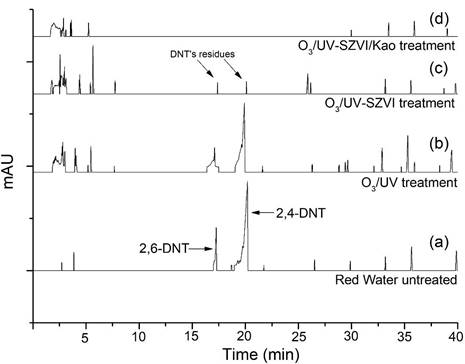Abstract
Nitroaromatic compounds have significant economic and industrial relevance in various inputs such as dyes, inks, agrochemicals, and explosives. In the manufacture of the explosive 2,4,6 trinitrotoluene (TNT), there is the formation of contaminated wastewater that is difficult to treat because it contains, among other compounds, high concentrations of 2,4 and 2,6-trinitrotoluene (DNT). In this work, the application of advanced oxidation processes of the O3/UV type was studied in sequential integration with catalytic material based on metallic iron slag (SZVI) and mineral matrix to treat an industrial effluent from the explosives industry contaminated with compounds nitroaromatics. Two types of mineral matrix composition were studied, kaolinite (Kau) and pumice powder (Pum), having been observed in the conditions of best efficiency (O3/UV-SZVI/Kau) 100% removal of both nitroaromatic compounds and residual ozone. On the other hand, photo-ozonation alone could only partially remove these components, with 38% DNT removal and 3.2 mg/L residual O3 observed, proving the importance of integration with the catalytic matrix for more effective treatment of the studied effluent.
Keywords:
DNT degradation; explosives industry effluent; Scrap zero-valent iron

 Thumbnail
Thumbnail
 Thumbnail
Thumbnail
 Thumbnail
Thumbnail


